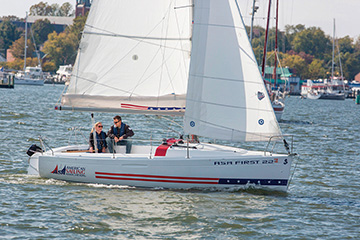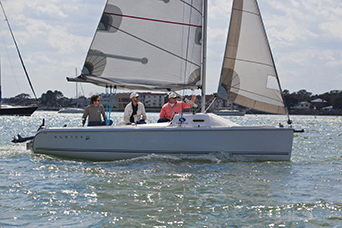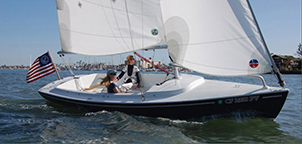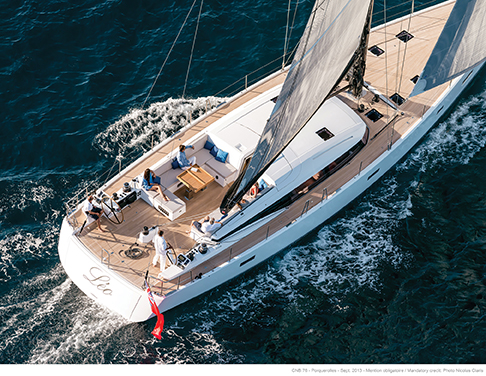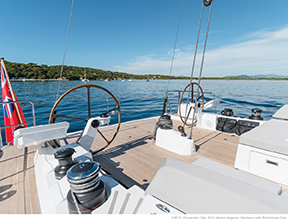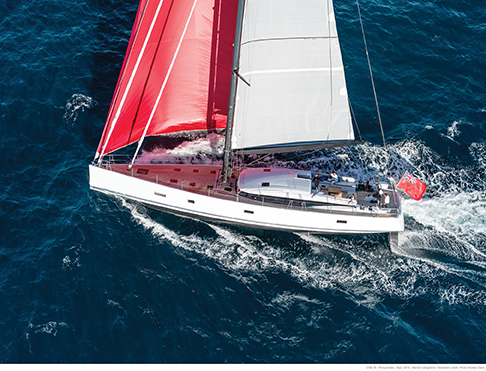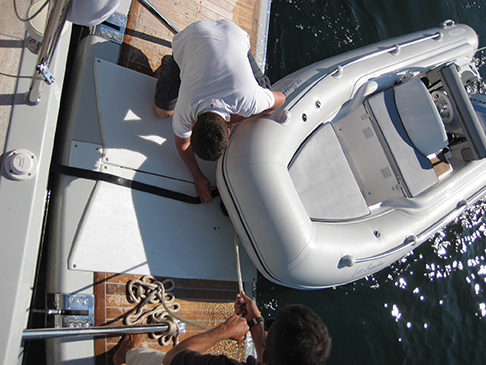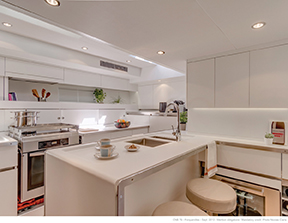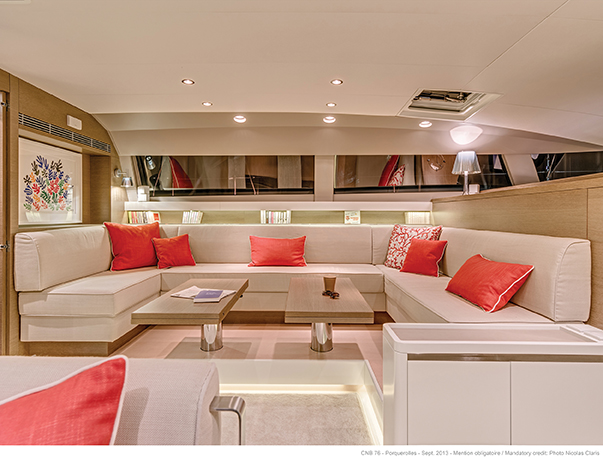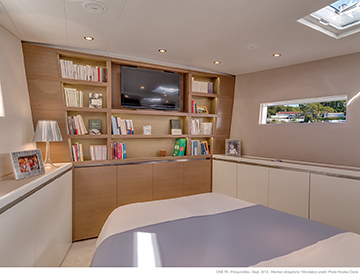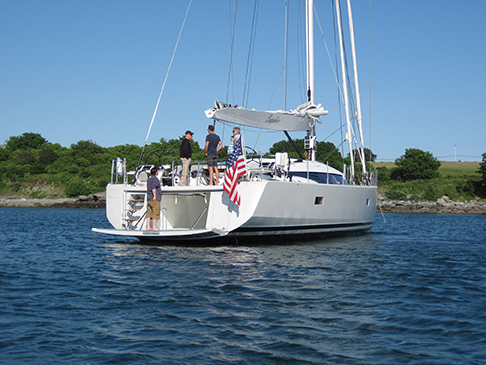New Cruising Monohulls for 2016
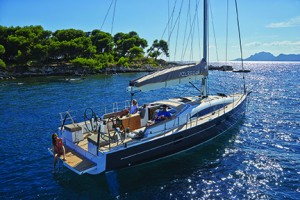 AZUREE 46
AZUREE 46
This new performance cruiser from Turkish builder Sirena epitomizes much of what is trending in the modern cruising fleet. The boat has a plumb bow and short sprit for downwind sails, a wide beam aft with hard chines and a broad fold down transom and an efficient fractional rig that is powerful and easy to tack. Down below, the interior is light, angular and modern and offers three good-size cabins. The galley and dinette and large enough for a party of eight at dinner time. The Azuree 46 sails very well and will be a truly capable passagemaker. www.berthonusa.com.
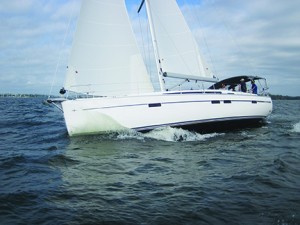 BAVARIA CRUISER 46
BAVARIA CRUISER 46
The Bavaria Cruiser 46 was voted “European Yacht of the Year” for 2015 by a panel of experts. The boat has a voluminous Farr-designed hull that provides very spacious accommodations below deck and a very stable sailing platform underway. With tight sheeting angles and an in-mast, roller-furling main, the 46 is both close winded and fast. Plus, the boat is simple for two people to sail. Down below the 46 has a traditional feel with teak or other darker hardwoods used for bulkheads and cabinets and a teak and holly sole. The three-cabin, three-head layout will appeal to families who enjoy having their own spaces. The 46 can be built with teak decks, so the overall feel of the boat can be a pleasing mixture of modern design and traditional appointments. www.bavariayachts.com.
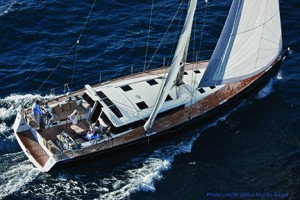
BENETEAU AMERICA
Being the world’s largest builder of sailboats, Beneteau always has a lot going on with new models, new editions and new concepts. This year, the company is introducing their new Oceanis 35 that follows the successful 38 and has the same layout options: daysailer, weekender or full on cruiser. The difference lies in the amount of interior joinery that is installed. Both are innovative concept boats and have really found followings among younger, free thinking sailors.
The First Series of racer-cruisers has been updated with the new Carbon upgrades for the boats that make them lighter and faster. A carbon bow sprit, boom and wheels all add to the carbon benefit.
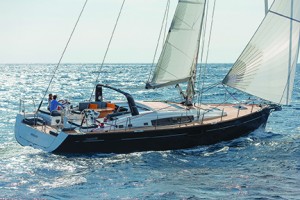 The new Beneteau Oceanis 60 is the company’s flagship and offers a true world-girdling design that will take a couple and their friends and family anywhere their wanderlust drives them. With a slippery hull that has proven fast in the light stuff and stable and reassuring in heavy weather, the 60 feels like a big boat, a proper yacht. The rig is simple to handle with electric winches and has the cockpit arch to keep the main sheet system out of the cockpit. The cockpit is huge and beneath it lies a full dinghy garage. Down below the 60 is extremely spacious with a huge master cabin forward and two comfortable guest cabins aft. Each cabin has its own head and shower. The saloon had a U-shaped dinette that will seat up to 10. The galley is more a floating kitchen and the chart table is a traditional working space for the skipper and navigator. The 60 is finished with mahogany colored joinery made from Alpi wood. The feel is quite traditional and truly evokes proper yachts from the ages. www.beneteauamerica.com.
The new Beneteau Oceanis 60 is the company’s flagship and offers a true world-girdling design that will take a couple and their friends and family anywhere their wanderlust drives them. With a slippery hull that has proven fast in the light stuff and stable and reassuring in heavy weather, the 60 feels like a big boat, a proper yacht. The rig is simple to handle with electric winches and has the cockpit arch to keep the main sheet system out of the cockpit. The cockpit is huge and beneath it lies a full dinghy garage. Down below the 60 is extremely spacious with a huge master cabin forward and two comfortable guest cabins aft. Each cabin has its own head and shower. The saloon had a U-shaped dinette that will seat up to 10. The galley is more a floating kitchen and the chart table is a traditional working space for the skipper and navigator. The 60 is finished with mahogany colored joinery made from Alpi wood. The feel is quite traditional and truly evokes proper yachts from the ages. www.beneteauamerica.com.
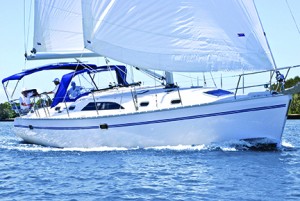 CATALINA 275 & 445
CATALINA 275 & 445
Although not entirely new, the Catalina 275 and 445, have proven to be very successful designs for the legendary American builder in the last few years, The 275 is a sport boat with weekending accommodations. Truly fun to sail, the 275 introduces modern design concepts that we expect to see repeated in larger models as the years go by. The 445 is the flagship of the line and the Catalina you would want for living aboard and long distance cruising. A wholesome design that is built to a very high standard, the 445 lives up to the company’s slogan, “The closer you look, the better we get.” www.catalina.com.
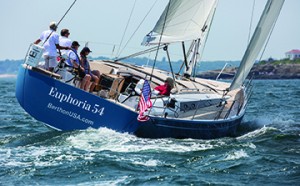 EUPHORIA 54
EUPHORIA 54
This brand new Germán Frers design, built by Sirena in Turkey, is one of the most stylish and appealing new cruising boats to come along in many moons. A thoroughly modern design, with a plumb bow, sleek lines, fractional rig and folding transom, the 54 does not seem extreme in any detail. Instead, at first look, the boat looks just right. Down below you can have a variety of options in the two after cabins and many custom details to choose from. The finish is superb. Best of all, the Euphoria sails like a dream. www.berthonusa.com.
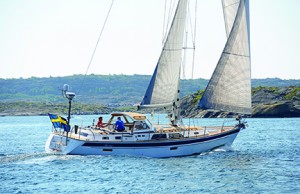 HALLBERG RASSY 43 MKIII
HALLBERG RASSY 43 MKIII
New last year, the Hallberg Rassy 43MKIII is the famous Swedish builder’s latest refinement of their ever popular and capable 43 foot, center cockpit cruiser. The hull and rig remain mostly the same and have proven to drive this sweet, seagoing hull very nicely. The changes below decks are mostly to improve the layout, make the forward bunks larger and to offer a centerline double berth in the master cabin aft. Still, the 43 like all of the line is finished below with traditional mahogany panels and cabinets. A boat for the long haul, the HR 43MKIII will last a lifetime or longer. www.hallberg-rassy.com.
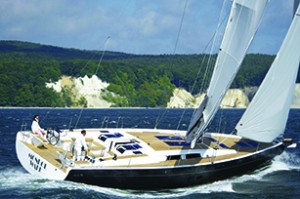
HANSE 575
German designed, engineered and built, the Hanse 575 is a thoroughly modern cruiser in the Euro style that is becoming so popular. The boat is massive inside and out with towering topsides and a huge beam that runs well aft. The plumb bow, vertical transom and flat sheer combine to give the boat a uniquely purposeful look and the big rectangular windows in the hull evoke Bauhaus modernism. Down below the 575 offers accommodations for six in three large private cabins with en suite heads. The saloon is bright and comfortable; the galley is more a modern kitchen than traditional galley; and, the dinette will seat up to eight for dinner. www.hanseyachts.com.
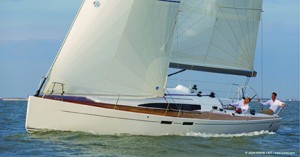 J/112E & J/122E
J/112E & J/122E
The J brand has long stood for a line that provides superior sailing performance in boats that also offer enough comfort and amenities to be true dual-purpose racer-cruisers. The new “E” designations that J Boats has added to the 97E, 112E and 122E stands for “elegance and evolution”. The boats are still very competitive around the buoys or in offshore point to point races. But, they also have been upgraded with finer interior joinery and detailing (including teaks decks if you so choose) that transforms the boats into proper yachts. For competitive sailors who want more elegance and evolution in their boats, the E series is for them. www.jboats.com.
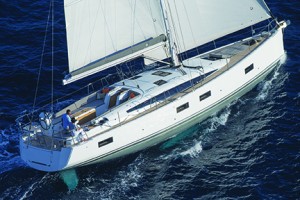 JEANNEAU 54 & 64
JEANNEAU 54 & 64
The brand new Jeanneau 54 that will debut in North America this fall is the little sister to the innovative 64 that was introduced last year. Both boats are designed by Philippe Briand and styled by Andrew Winch. The new boats are decidedly different and more modern than anything Jeanneau has come out within a while. The hulls have nearly plumb bows and nicely angled transoms so they don’t look boxy. The chines aft add volume to the after cabins and will add sailing power when broad reaching. The huge cockpits will make wonderful warm weather living spaces and with the stern platform folded down, the space is really expansive. The 64 has a dinghy garage under the cockpit; the 54 has unique retractable davits that can hold a 11-foot RIB. Down below, Winch has made good use of the volume. In the 64, you can have up to five private cabins or chose to go with two truly elegant sleeping cabins. In the 54, the basic plan shows a standard three cabin configuration with an option for two pullman cabins forward instead of the large master suite. Jeanneau is evolving their design concepts, which is why the company remains a leader among production builders. www.jeanneau.com.
 MOODY 54DS
MOODY 54DS
The deck saloon concept has had many interpretations but the way that the designers at Moody have gone is completely unique. The single level living idea, similar to cruising catamarans, means that the Moody 54DS’s cockpit flows aft to a large swim platform and forward right into the saloon. With a hardtop over the cockpit that slides open and closed, the exterior spaces are useful in all weather. The 54DS is a great liveaboard cruiser that will be spacious enough for entertaining or cruising with another couple or two. Moody Yachts are built by Hanse in Germany and sold in the US through Berthon USA. www.berthonusa.com.
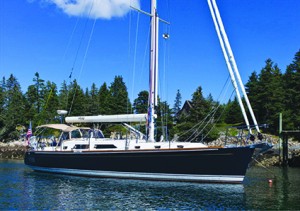 OUTBOUND 46
OUTBOUND 46
Designed by the late Carl Schumacher, the 46 is built to be both solid in a seaway and fast on passage. The hull is long and lean and has proven capable of high sustained average speeds. The interior is traditional and elegant with lots of varnished joinery and intricate detailing. The 46 is a voyager’s boat that over the years has made many long and interesting cruises. In last year’s Salty Dawg Rally seven 46s made the 1,350 mile passage with the fleet to the BVI. www.outboundyachts.com.
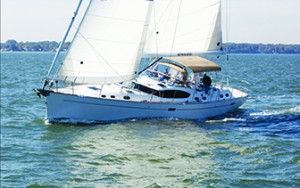 PASSPORT VISTA 545AC & 61
PASSPORT VISTA 545AC & 61
The aft cockpit version of the Vista 545 provides her owners with a larger cockpit that will seat eight or more for sundowners but is compact enough to be very useful for small crews to handle sheet and lines while underway. It doesn’t open to the stern platform; instead there is a large lazarette for deck gear. Down below, the 545 has the classic appeal of varnished teak, teak and holly soles and finely built furniture. A great couple’s cruising boat, the 545 has lots of storage space and tankage for the long haul. The 615 is the big sister of the Passport fleet and is a true world cruiser with accommodations for a full family or a large crew of friends. The details of the new Passports tell a lot about their quality and their durability. Even the engine room is fitted out in yacht style and quality. For sweet sailing, offshore capable yachts, the new Passport Vista 545AC and 615 will be hard to beat. www.passportyachts.com.
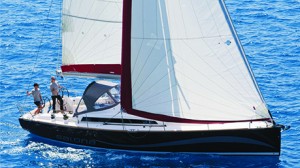 SALONA 41
SALONA 41
The new Salona 41 is a performance cruiser, designed by J&J, that puts the emphasis on performance in much the same way J Boats does. Last winter the Salona 44 finished first and third in the St. Barths regatta and finished in the top three in Antigua. The new 41 is even faster and has already won events in Europe. But, it is also a fine cruising boat for a family that enjoys sailing well. The Salona fit and finish is excellent and the overall package is a great value. www.salonayachts.com.
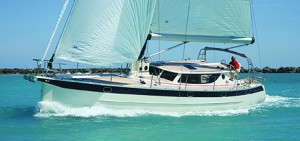 SEAWARD 46
SEAWARD 46
This year, Seaward Yachts has moved their production to Island Packet Yachts where the boats are now being built under contract. The flagship of the fleet is the Seaward 46 that combines innovative shoal draft or lifting-keel technology with sailing systems that can easily be handled by a singlehander. With twin engines, the 46 can power like a motorboat or under sail will keep up with any cruising boat in this size range. The shallow draft makes the 46 the perfect boat for the west coast of Florida, The Bahamas, Chesapeake Bay and southern New England. www.seawardyachts.com.
 X-YACHTS XC 45
X-YACHTS XC 45
The Danish built XC 45, designed by Nils Jeppesen, is the first in the new cruising line to be built by X-Yachts. Although not new to the European market, the XC 45 is new to North America. The boats carries a lot of the racing pedigree that has made X-Yachts one of Europe’s largest and most successful builders of racing boats. But, it is truly a performance cruiser with a luxuriously fitted out interior. The XC 45 will make a fine family cruiser with three sleeping cabins and a large airy saloon. The aft galley will be excellent at sea. A very high quality cruising boat that will acquit herself well against any of her peers, the XC 45 compares favorably with any cruising boat in this size range. www.x-yachts.com.
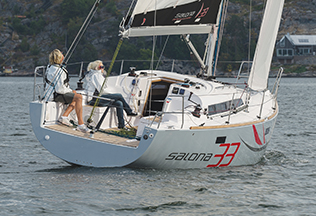 We found the 33 in her slip in a marina up the bay and quickly got her sail covers off, the engine cranked up and the sheets led. The boat we sailed had the optional twin wheels instead of a tiller, which seems like overkill for a 33 footer but actually works very well.
We found the 33 in her slip in a marina up the bay and quickly got her sail covers off, the engine cranked up and the sheets led. The boat we sailed had the optional twin wheels instead of a tiller, which seems like overkill for a 33 footer but actually works very well.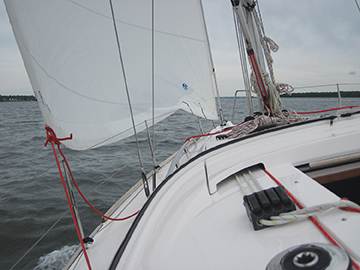 We fell off the wind and broad reached back toward the marina, sailing at about 160 degrees apparent and jibing easily to maintain our course. It was a shame we did not have the asymmetrical chute aboard; it would have been a blast to feel the slippery little boat really fly under the press of a downwind sail. As it was, we maintained six knots with the apparent wind at six knots off the quarters.
We fell off the wind and broad reached back toward the marina, sailing at about 160 degrees apparent and jibing easily to maintain our course. It was a shame we did not have the asymmetrical chute aboard; it would have been a blast to feel the slippery little boat really fly under the press of a downwind sail. As it was, we maintained six knots with the apparent wind at six knots off the quarters.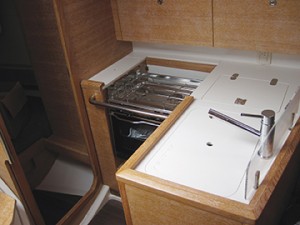 Walking forward along the side deck, you have plenty of deck width and good places to hang on in bumpy conditions. While aft, the open transom provides easy access to a dinghy or doubles as the swim platform.
Walking forward along the side deck, you have plenty of deck width and good places to hang on in bumpy conditions. While aft, the open transom provides easy access to a dinghy or doubles as the swim platform.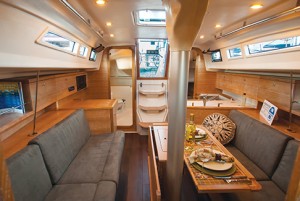 The saloon has a centerline table with folding leaves that will seat four comfortably but can accommodate six in a pinch. The chart table is a proper nav station that will fit a chart and has room to mount all of the electronics you might need. The galley has a two-burner stove-oven and plenty of locker space. The spaces are all well laid out so even with four adults below decks, you will be able to sit, eat, cook and navigate without always bumping into your partners.
The saloon has a centerline table with folding leaves that will seat four comfortably but can accommodate six in a pinch. The chart table is a proper nav station that will fit a chart and has room to mount all of the electronics you might need. The galley has a two-burner stove-oven and plenty of locker space. The spaces are all well laid out so even with four adults below decks, you will be able to sit, eat, cook and navigate without always bumping into your partners. The Salona 33 is built in a modern facility in Croatia using the most modern techniques and materials. The hull is a vacuum bagged, infused laminate that is fitted with a structural grid that anchors the furniture, provide stiffness to the hull, supports the keel and offers a solid base for the keel-stepped mast. Although we did not press the 33 during our test sail, she certainly was stiff and solid underfoot.
The Salona 33 is built in a modern facility in Croatia using the most modern techniques and materials. The hull is a vacuum bagged, infused laminate that is fitted with a structural grid that anchors the furniture, provide stiffness to the hull, supports the keel and offers a solid base for the keel-stepped mast. Although we did not press the 33 during our test sail, she certainly was stiff and solid underfoot.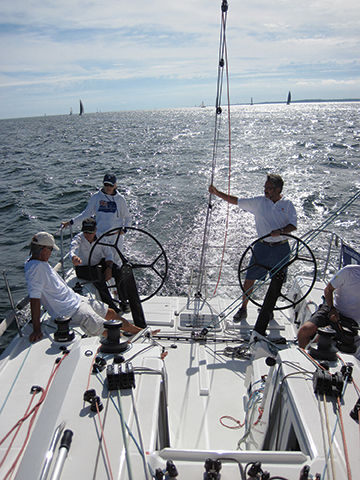
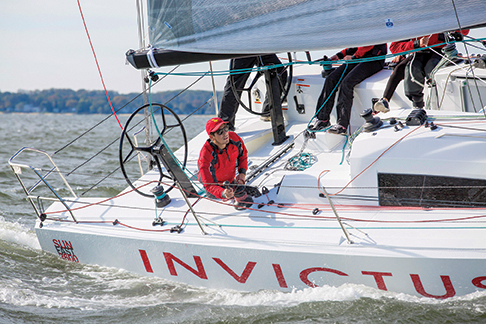
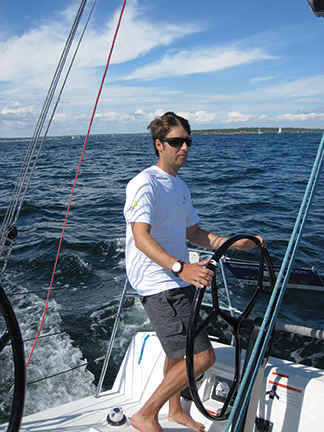

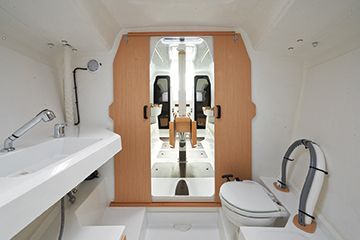
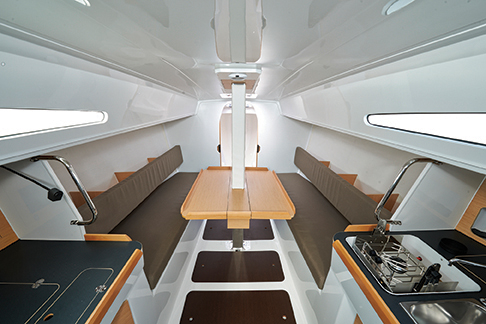
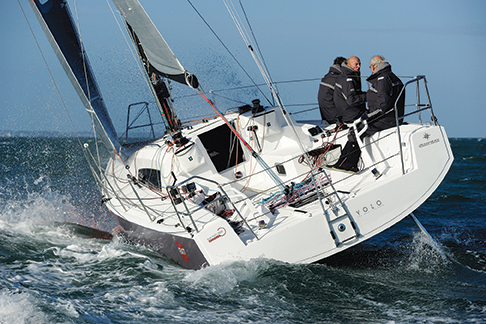







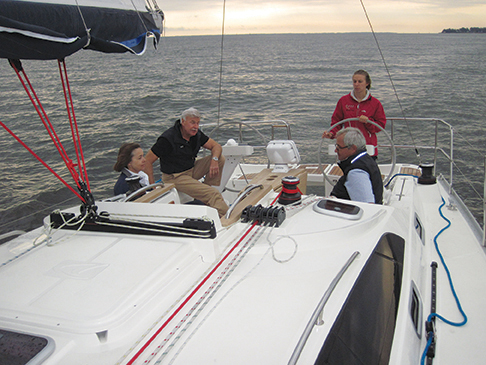

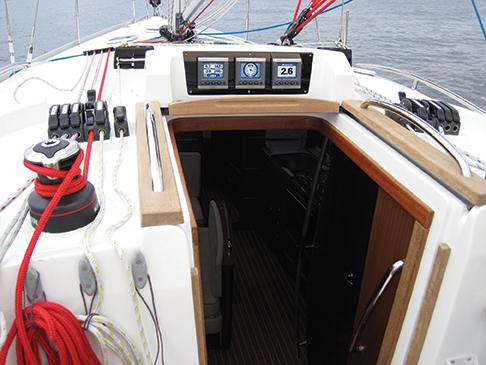
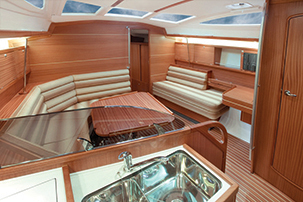
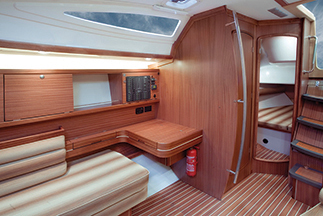
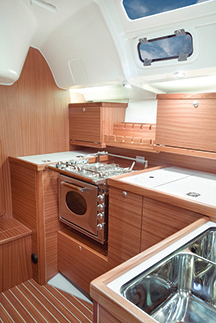
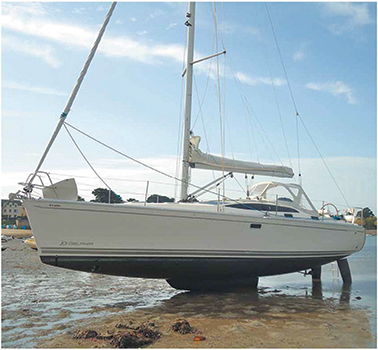
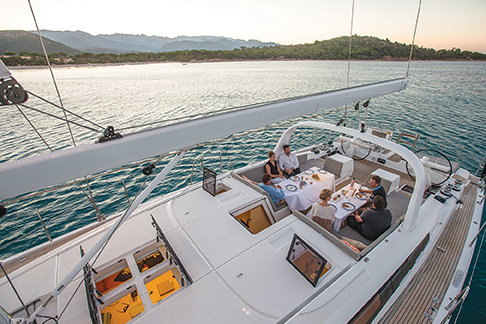
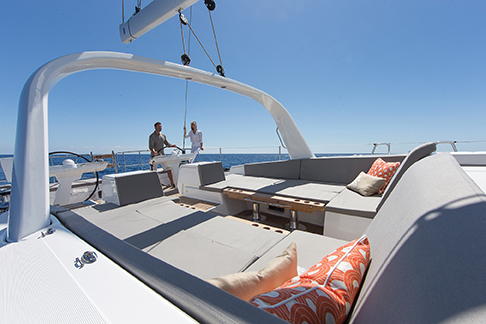
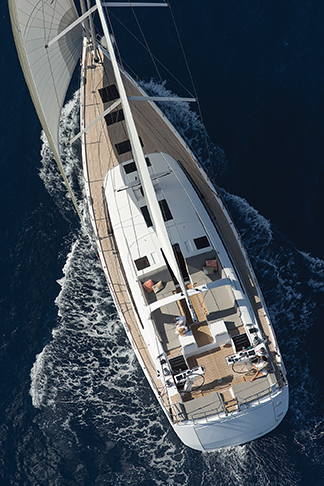
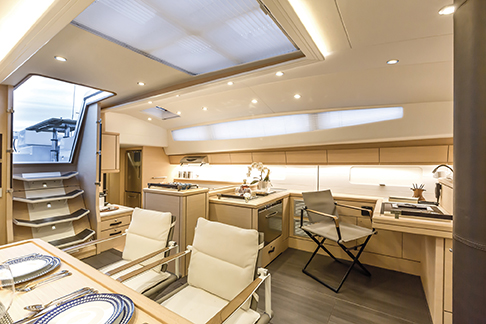
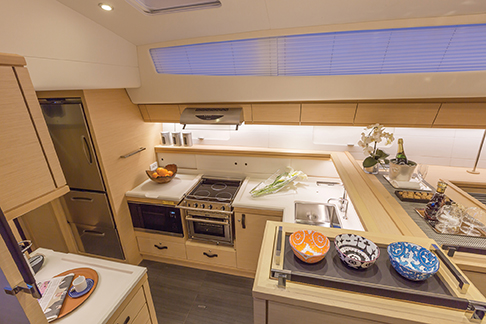
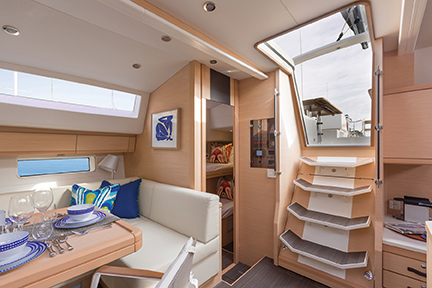
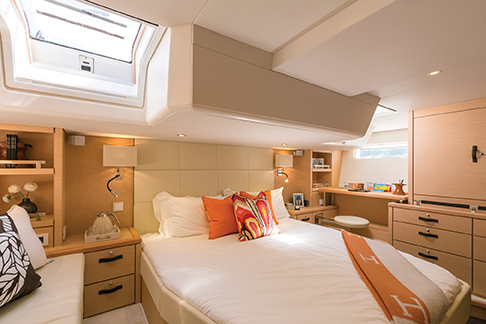
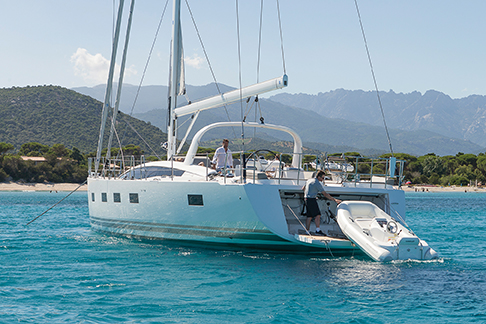

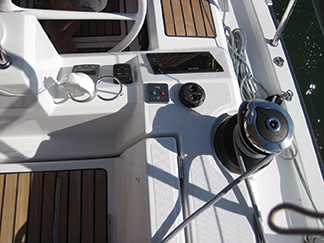
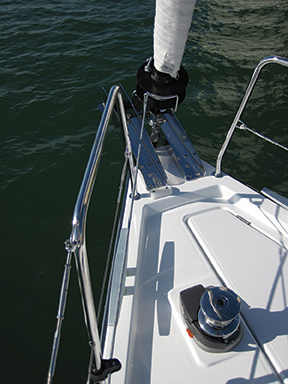
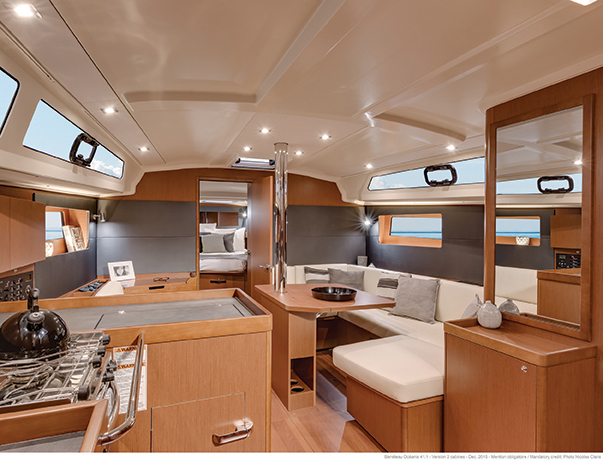
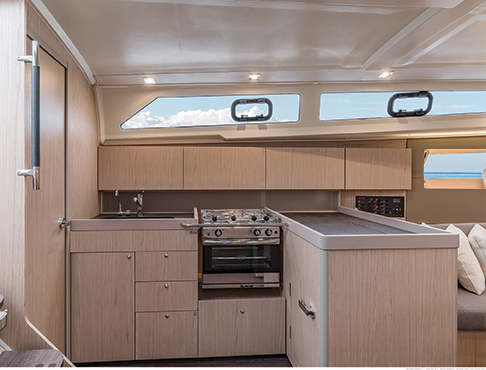
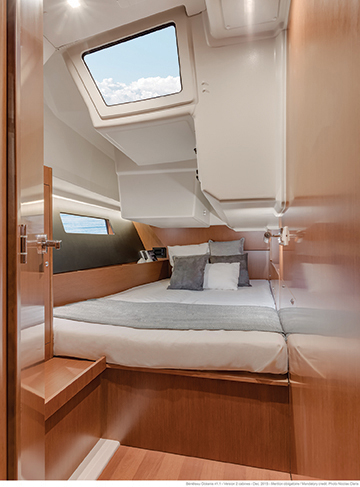
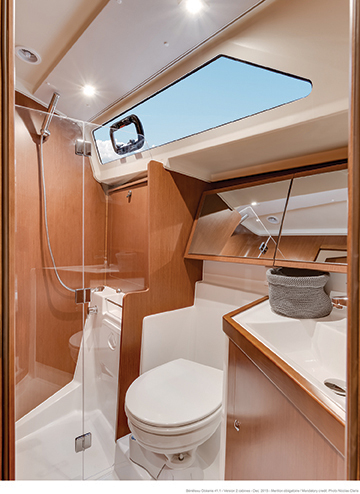
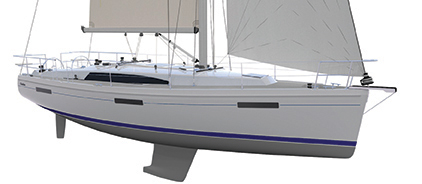
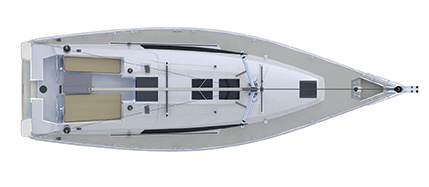
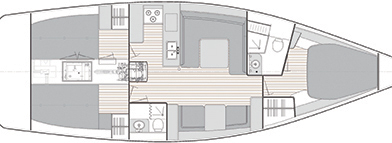






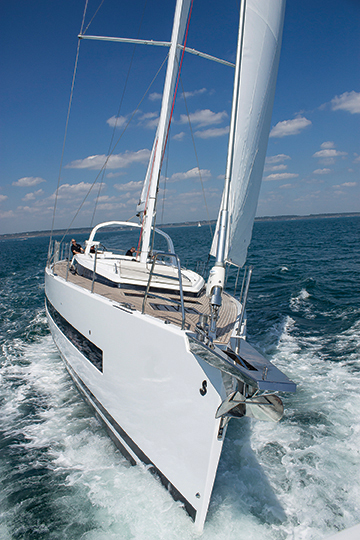




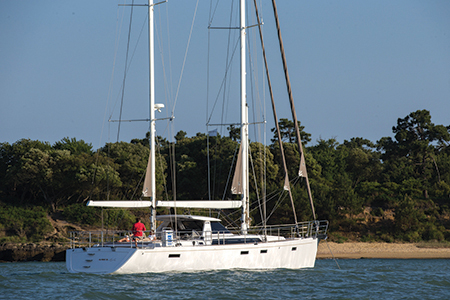
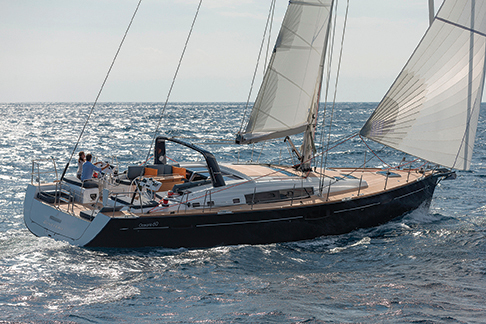
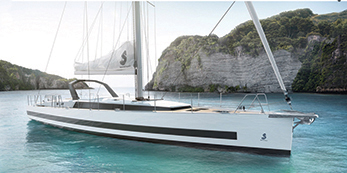
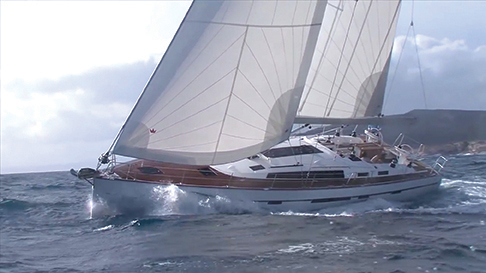
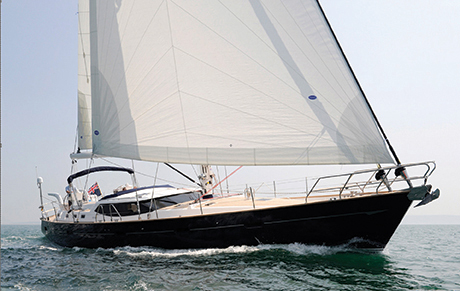
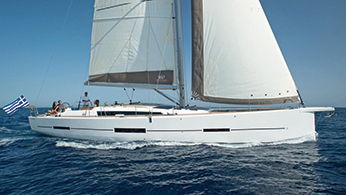
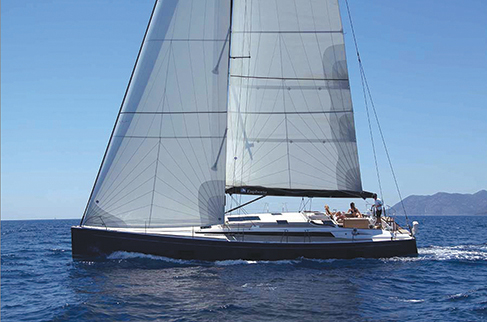
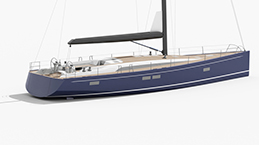
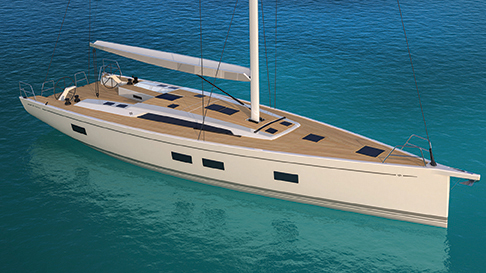
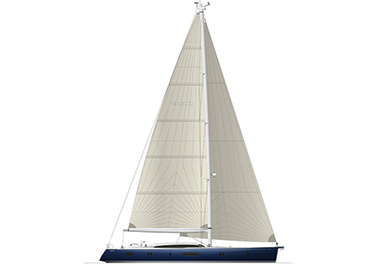
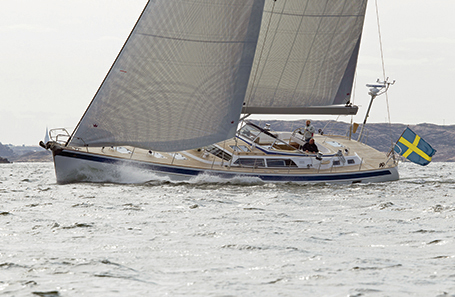

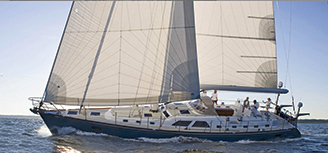
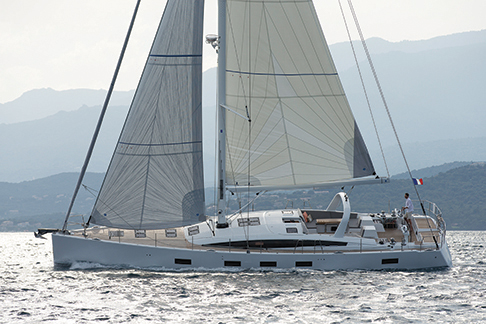
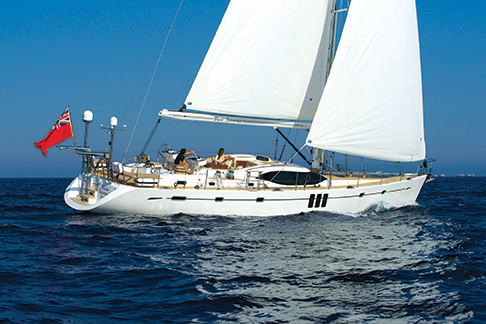
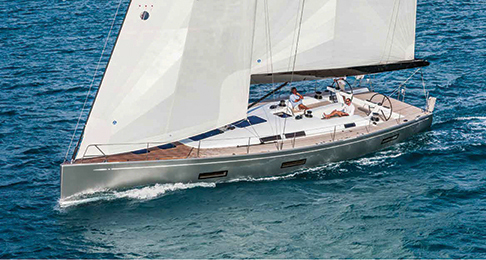
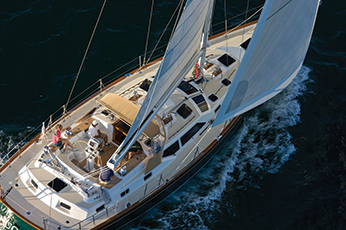
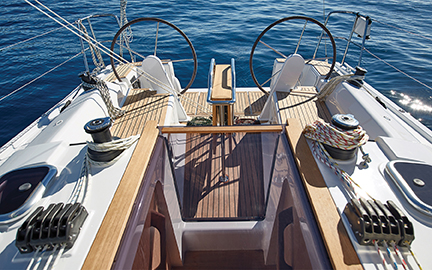 Twin carbon wheels, by the Danish company Jefa, open up the cockpit and provide good sightlines forward as well as a smooth flow from the companionway to the drop down transom (manual) which creates a nice swim platform. The twin backstays also help in keeping the stern clear of obstacles and are placed well so a tall helmsman can still stand at the wheel without hitting his head on the wires.
Twin carbon wheels, by the Danish company Jefa, open up the cockpit and provide good sightlines forward as well as a smooth flow from the companionway to the drop down transom (manual) which creates a nice swim platform. The twin backstays also help in keeping the stern clear of obstacles and are placed well so a tall helmsman can still stand at the wheel without hitting his head on the wires.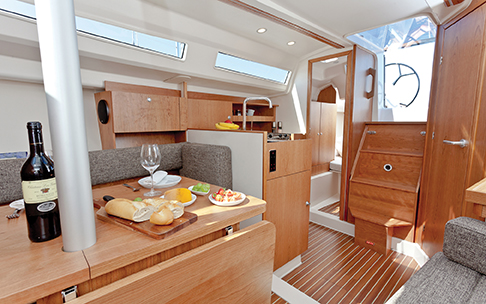
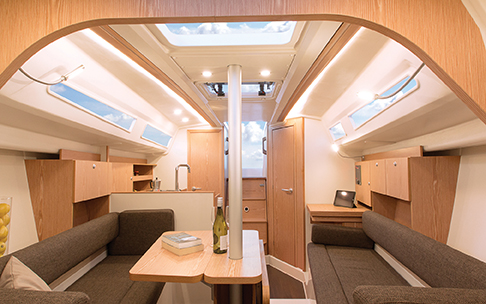 The companionway steps are well angled whether you’re coming up or down. This is a surprising luxury on a small boat where ladders are more the norm. Moving about and popping below is easier especially when heeling. One sacrifice is in the head that has no separate shower stall. It is still roomy with a sink, a Jabsco manual toilet, some storage and adequate room to change clothes. The standard interior finish on this model is a satin mahogany with upgrades to either light Italian oak or warm American cherry and fabric finishes allow every owner to personalize the décor.
The companionway steps are well angled whether you’re coming up or down. This is a surprising luxury on a small boat where ladders are more the norm. Moving about and popping below is easier especially when heeling. One sacrifice is in the head that has no separate shower stall. It is still roomy with a sink, a Jabsco manual toilet, some storage and adequate room to change clothes. The standard interior finish on this model is a satin mahogany with upgrades to either light Italian oak or warm American cherry and fabric finishes allow every owner to personalize the décor.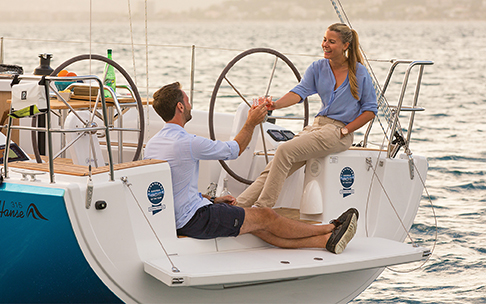
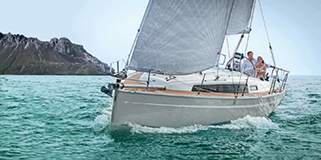
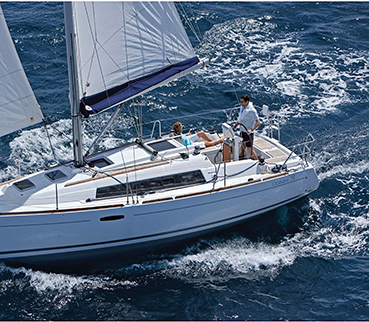
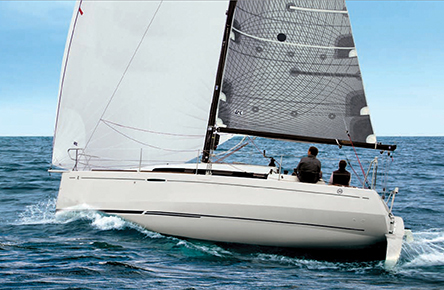
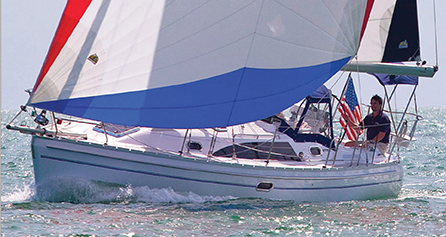
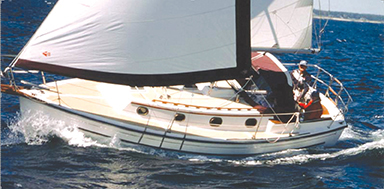
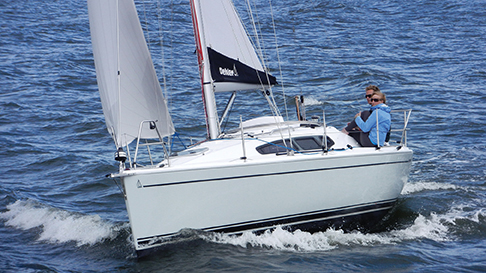
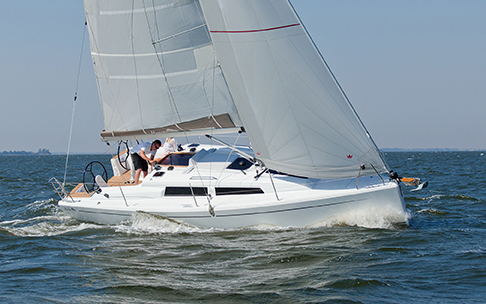
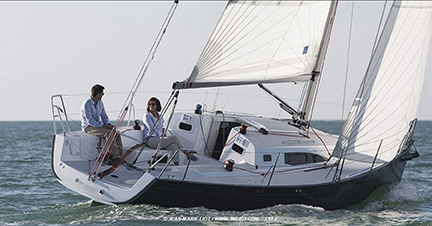
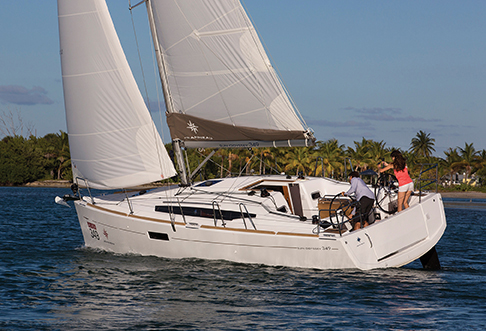
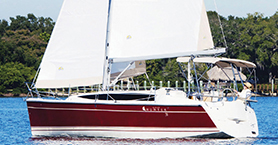
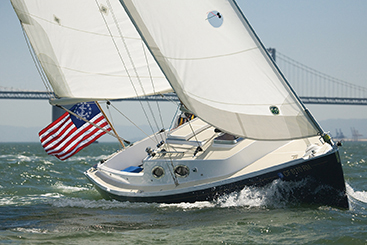
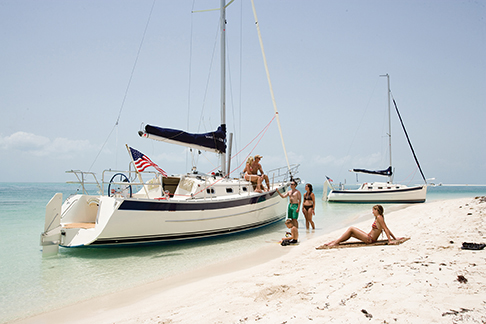
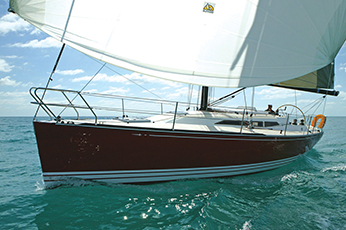
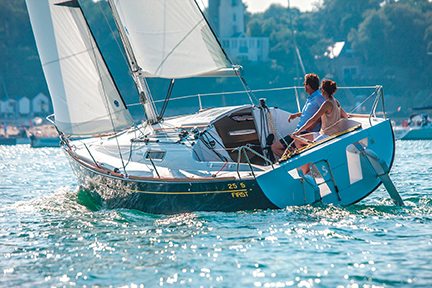
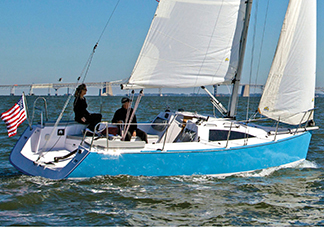
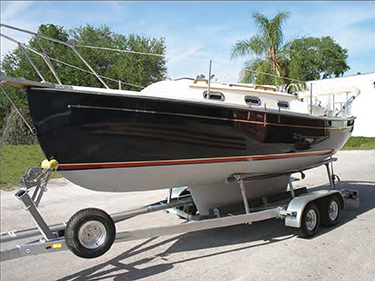
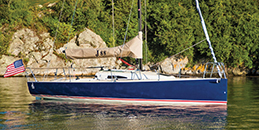
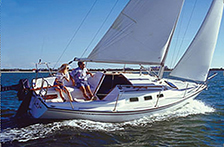
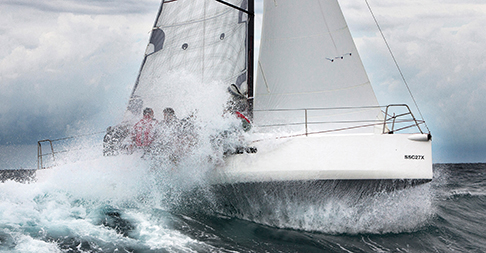
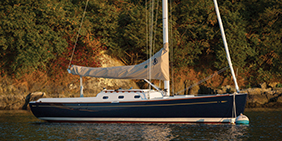
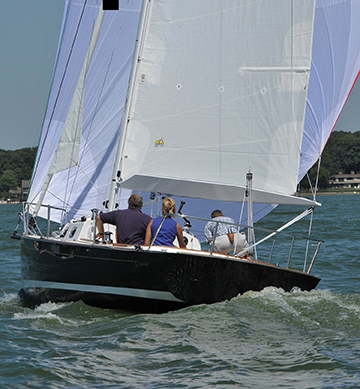 TARTAN
TARTAN